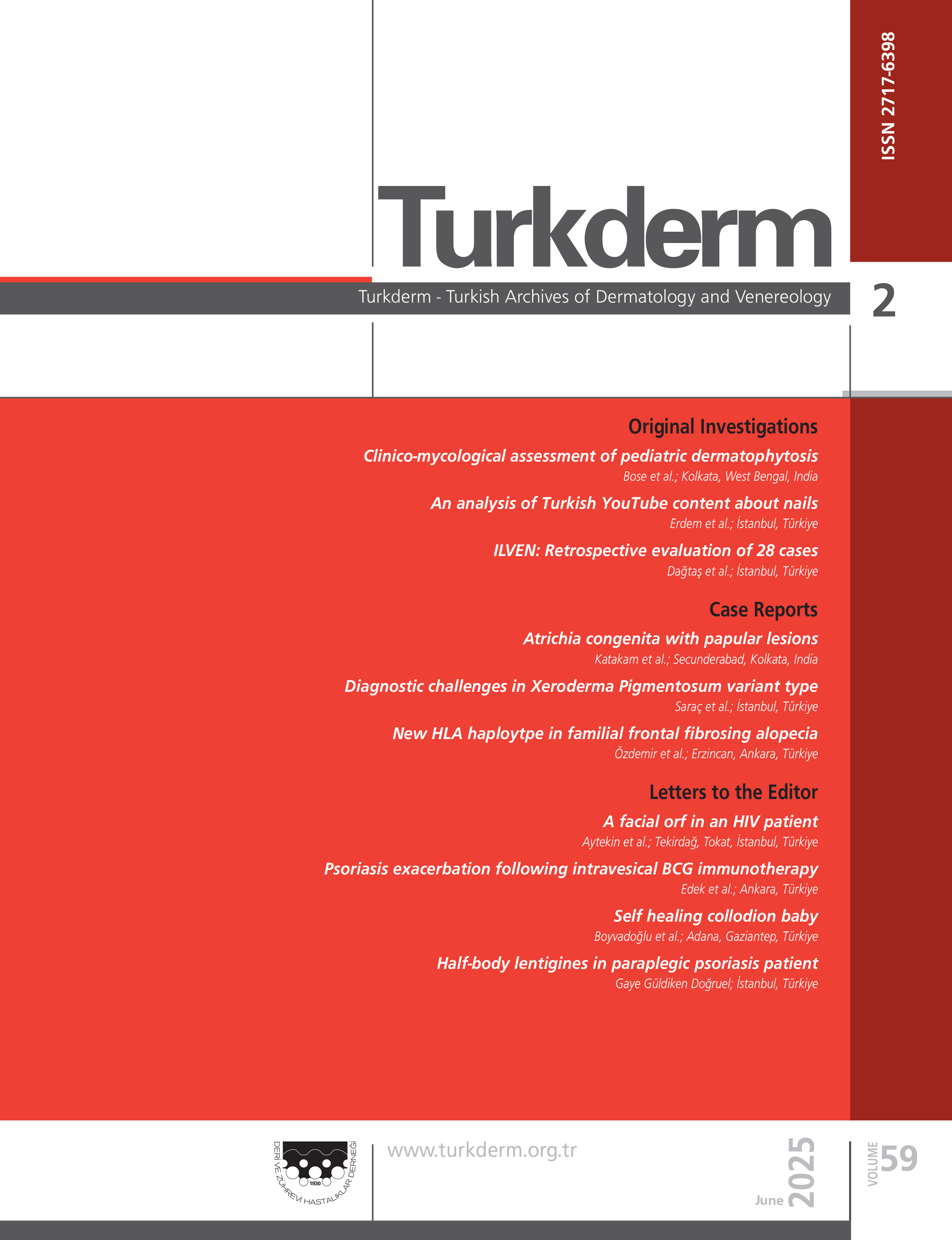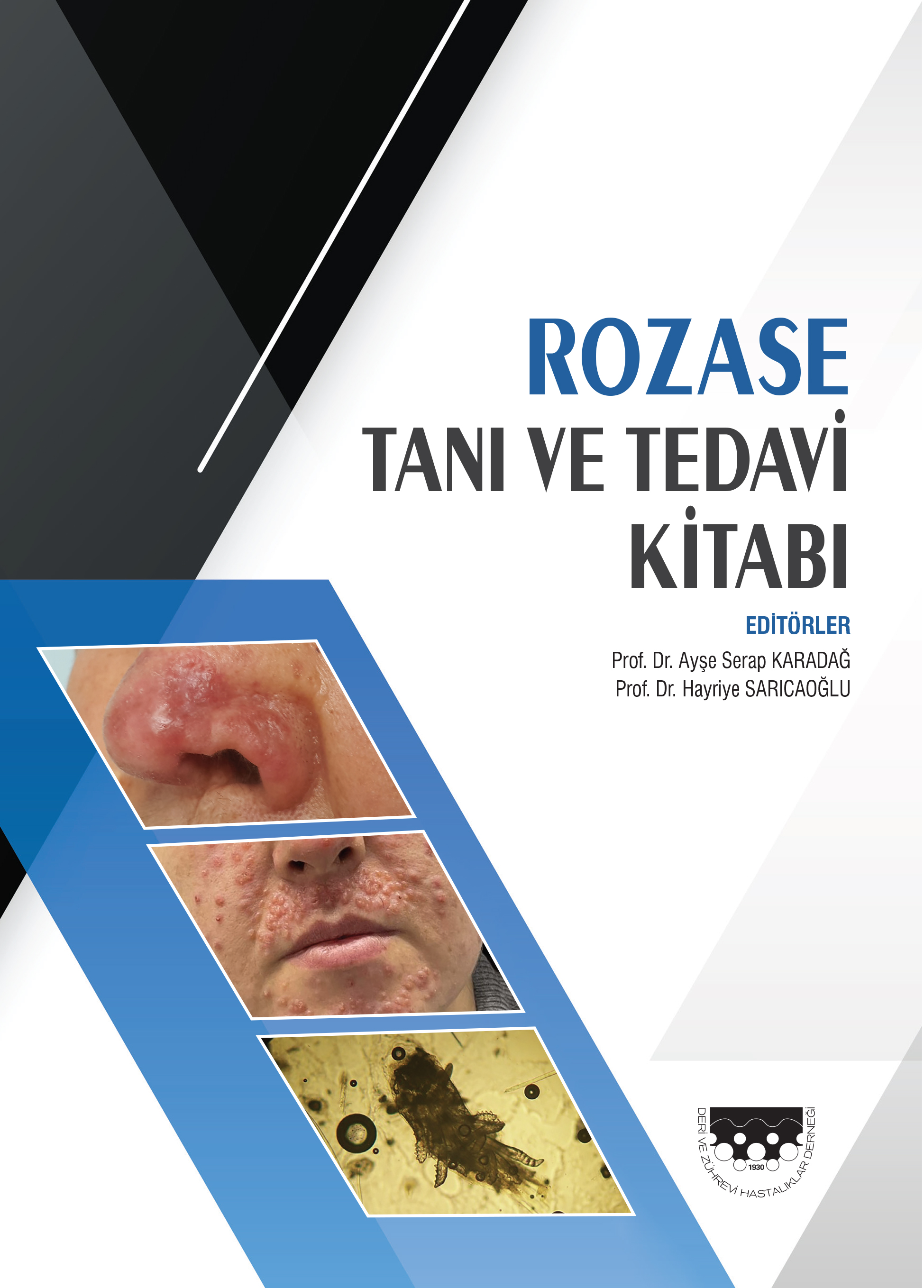Volume: 36 Issue: 3 - 2002
| EDITORIAL | |
| 1. | Oral mukoza kontakt dermatitlerine yaklaşım Özlem SuPage 171 Abstract | |
| REVIEW ARTICLE | |
| 2. | Vasculitis of classification: Historical progression Sevgi Bahadır, Savaş Yaylı Pages 173 - 177 Vasculitis is inflammation of a vessel wall. The systemic vasculitides represent a highly heterogeneous group of clinicopathological entities. In 1952, Zeek became the first author to incorporate a clinicopathological assessment based on the size of the vessels involved in the inflammatory process in her classification of necrotizing vasculitis. A number of alternative classification systems were proposed later. In this respect, different names were suggested to the same diseases, where as different diseases were referred by the same. During the Chappel Hill Consensus Conference in 1993, the classification proposed by a commitee experienced in the diagnosis of vasculitis based on the diameter of the effected vessels, is still valid. |
| ORIGINAL INVESTIGATION | |
| 3. | The role of psychological factors in alopecia areata and the impact of the disease on quality of life A. Tülin Güleç, Nilgün Taşkıntuna, Çağtay Duru, Yasemin Saray, Cenk Akçalı Pages 178 - 181 Background and design: The role of psychological factors in the pathogenesis of alopecia areata (AA) has long been a subject of debate. This case-control study was undertaken to determine the significance of stressful life events and the other psychological factors in the etiopathogenesis of AA. The impact of the disease on quality of life was also assessed. Materials and Methods: Fifty-two adult patients (18 females, 34 males) diagnosed with AA and 52 age- and sex-matched individuals selected from hospital personal without any hair loss as a control group were evaluated with major life events scale, Beck depression and Beck anxiety inventories, and 36-item short form health survey (SF-36). Results: There was no statistical difference between the patient and control groups regarding the total scores of the stressful life events, depression and anxiety. Of the 8 subscales of SF-36, three of them (vitality, social functioning and mental health scores) turned out to be statistically significant between the two groups. Conclusions: Our data provides no evidence that psychological factors are involved in the pathogenesis of AA. On the other hand, our findings indicate that AA has a partly negative impact on quality of life, so we think that psychologic intervention should be useful in selected patients for an effective treatment. |
| 4. | Anti-gliadin antibodies in psoriasis Aylin Kalaycıyan, Aykut Çelik, Tufan Kutlu, Güngör T. Tümay, Agop Kotogyan Pages 182 - 187 Background: Psoriasis is a hyperproliferative and papulosquamous skin disorder that affects 1-2% of the population. Despite extensive studies done, aetiology is still to be elucidated. Recently, gluten hypersensitivity and a possible enteropathy are being investigated in psoriasis. As a population, with a diet mainly based on cereals like wheat, we have studied the presence of gluten hypersensitivity in psoriasis and its possible influence on the general manifestations of the disease. Materials and methods: IgG and IgA type antibodies to gliadin were quantified in 127 patients with psoriasis, the age and sex matched control group of 31 individuals and 6 patients with celiac sprue. A possible impact of the presence of antigliadin antibodies on the disease characteristics, namely arthropathy, clinical presentation, age of onset, gastrointestinal symptoms and the presence of a psoriatic family member, was investigated. Results: It was found that 16.5% of patients with psoriasis had serum levels of IgA antibodies to gliadin. Despite being relatively a high percentage when compared to those of the control group (%9.6), it was not a statisticallysignificant increase. The presence of antibodies to gliadin had no influence on the disease characteristics. Conclusion: Despite being insignificant, an increase in the presence of antibodies to gliadin was noted in patients with psoriasis. There seems to be a subgroup of psoriasis patients with positive antibodies to gliadin but without gastrointestinal symptoms. Along with other studies, it seems to be important to try to identify this subgroup, which might benefit from a gluten-free diet. |
| 5. | The role of antigliadin antibodies and their relation with HLA antigens in activation of psoriasis vulgaris Kenan Aydoğan, Necdet Tokgöz, Şükran Tunalı Pages 188 - 193 Background and Design: Recent reports about the association of gluten sensitive enteropathy (GSE) and psoriasis vulgaris (PV) of unknown etiology are noteworthy. In our study we investigated the positivity of IgA and IgG antigliadin antibodies (AGA) which are related with GSE in PV patients as well as their relation with HLA antigens. Materials and Methods: IgA AGA and IgG AGA, immunoglobulins, complement C3c and C4, eosinophil cationic protein(ECP), total IgE levels, gluten spesific IgE antibodies and HLA class I(ABC) and class II (DR, DQ) antigens were investigated in 42 cases diagnosed as psoriasis vulgaris clinically and histopathologically, the control group included 40 healthy volunteers for serological comparison, 71 healthy volunteers were also evaluated for HLA antigens. Results: While there was no statistically difference between study and control groups in respect with IgA AGA positivity (p=0.056). Positivity for IgG AGA, IgA or/and IgG AGA were statistically different (p=0.001, p=0.03 respectively). In the study group there was no difference of total IgE level, ECP and gluten spesific Ig E results in IgA and /or IgG AGA positive and negative patients. Serum total IgA antibody level was significantly elevated in IgA AGA positive and IgA and/or IgG AGA positive patients (p<0.01, p<0.05 respectively). When HLA Class I antigens were compared in study and control group, HLA-A32 positivity was significantly more frequent in IgG AGA positive patients (p=0.02), HLA-A30 was found to be elevated in IgG AGA negative and IgA AGA negative patients. Elevations of HLA-DR16 and HLA-DQ1 were found in IgG AGA positive patients (p=0.01, p=0.006 respectively) and HLA-DQ1 was found to be elevated in IgA AGA positive patients (p=0.01). HLA-DR14 was elevated in IgA AGA negative patients(p=0.01). Conclusion: In conclusion, different genetic structures may be risk factor for the formation of gluten sensitive autoantibodies in active PV. The development of these antibodies may be factors or cofactors in PV etiopathogenesis. We suggest that the results of our preliminary study should be confirmed with further research. |
| 6. | A. Clinical staging and results of therapy in patients with Mycosis Fungoides Hayriye Sarıcaoğlu, Rıdvan Ali, Fahir Özkalemkaş, Kenan Aydoğan, Şükran Tunalı, Mehmet Tunalı Pages 197 - 200 Background: Mycosis Fungoides is the most common primary skin lymphoma and clinical stating of this disease is very important for determination of the treatment and prognosis. Method: The clinical signs of 16 patients, aged between 44 and 60, who had been followed from November 1987 to May 1997 in Uluda¤ University Medical Faculty with a diagnosiss of Mycosis Fungoides were reviewed. Result: Ten of the patients were in stage I B, 1 in II A, 3 in II B and 1 in IV B. Conclusions: The results of study, which has shown that 62.5 % of cases applied to our clinic in stage I B, supports the idea of better clinical response in eraly stages as well. |
| 7. | The prevalance of acne vulgaris in primary schools in the city center of Sivas Ahmet Güldü, Melih Akyol, Sedat Özçelik, Mehmet Marufihah, Murat Polat Pages 202 - 205 Background and design: Acne vulgaris is one of the most common skin diseases. Acne is usually considered a disorder of adolescence. A number of studies have examined the prevalance of acne in adolescent population, however, there are few studies in the literature concerning the epidemiology of acne vulgaris, especially early stages of puberty. The aim of this study was to assess the prevalance and severity of acne vulgaris in primary school children in Sivas. Methods: One thousand eight hundred ninety two children were examined for facial acne. The severity of acne vulgaris has been defined as mild, moderate, and severe. The prevalance of acne vulgaris was analysed statistically. Results: We found that the prevalance of acne vulgaris in primary school children was 16.7%. Acne was present in 13.4% of males and 20.2% of females. The majority of children with acne vulgaris (94.94%) were aware from their acnes. Conclusion: It should be taken into consideration age, gender, environmental factors, and socioeconomic factors in the evaluation of acne vulgaris in primary school chidren. |
| TURKDERM-9860 | |
| 8. | Rudimentary polydactyly Özlem Yerebakan, Mehmet Akif Çiftçioğlu, Oya Ermiş, Bahar Kılıçaslan, Serdar Tüzüner, Ertan Yılmaz Pages 208 - 210 Rudimentary polydactyly is an amputation neuroma secondary to the destruction of supernumerary digits in utero, characterised by small papules attached to the lateral aspect of the fifth finger. The striking histopathologic features are the marked neural proliferation in the dermis and the large number of Wagner-Meissner bodies in the dermal papillae. Here, we present a 21-year-old female patient with bilateral rudimentary polydactyly representing typical clinical and histopathological features and, we review the differential diagnosis of the case. |
| 9. | Hypohidrotic ectodermal dysplasia with bilateral athelia: a case report. Bilal Doğan, Oktay Taşkapan, Yavuz Harmanyeri Pages 211 - 212 Hypohidrotic ectodermal dysplasia (HED) shows X-linked recessive inheritance in almost all cases. The main features are hypotrichosis, absent or reduced sweating and partial or total anodontia. We present a male infant who has HED with bilateral athelia, because it is rarely seen. |
| 10. | Acute generalized exanthematous pustulosis induced by penicilline: case report Evren Sarıfakıoğlu, Tülin Güleç, Deniz Seçkin Pages 213 - 216 Acute generalized exanthematous pustulosis is a rare pustular dermatosis that has been recently described. Drugs mainly antibiotics, viruses, contact with mercury and food poisoning have been implicated in the etiopathogenesis of this disorder. The clinical manifestations are characterized by the acute onset of numerous, nonfollicular, sterile, superficial pustules located on widespread erythema. Fever and leukocytosis may frequently accompany this dramatic situation where rapid spontaneous recovery is typical. Herein, we present a 24-year-old male patient who had acute generalized exanthematous pustulosis after penicilline treatment. |
| 11. | A case of malignant eccrine poroma on the leg Can Ceylan, Fezal Özdemir, Alican Kazandı, Gülşen Kandiloğlu, Sezer Erboz Pages 218 - 220 Malignant eccrine poroma is an uncommon neoplasm which shows differentiation throughout intraepidermal and dermal duct of eccrine sweat gland. A case of malignant eccrine poroma on the left leg in a 70-year-old female is described with a review of the literature. Following the surgical excision, the lesion was evaluated by routine histopathology and immuno-histochemical staining. In the histopathological evaluation, the tumour cells arise from epidermis extended into the dermis forming chordons and islands. The tumour cells showed nuclear atypia, pleomorphism and abnormal mitotic figures. In addition, dyskeratotic cells and ductal differentiation areas were seen among tumour cells. mmunohistochemically, carcinoembryonic antigen was positive in the areas of ductal differentiation. Two years of follow-up revealed no recurrence or metastasis of the tumour. |
| 12. | A case of pyoderma gangrenosum associated with rheumatoid arthritis Ayşın Köktürk, Aziz Yazar, Tamer İrfan Kaya, Aynur Koca Pages 221 - 222 Pyoderma gangrenosum is an ulcerating skin disease which often occur in association with chronic inflammatory or malignant disease: Ulcerative colitis, rheumatoid arthritis, Crohns disease, IgA monoclonal gammopathy, chronic active hepatitis, HIV enfection, and hematologic and lymphoreticular malignancies are among the many diseases seen in conjunction with pyoderma gangrenosum. We present a rheumatoid arthritis patient with typical lesions of pyoderma gangrenosum. |
| CONTINUING MEDICAL EDUCATION | |
| 13. | Green tea in dermatology Ulviye Atılganoğlu Pages 223 - 226 Oxidative stress and UV irridation have significant effects on the development of skin inflammation, premature aging and skin tumors. Polyphenols have strong antioxidative effects and green tea is a rich source of polyphenols (%30). The results of the studies done with animal models and volunteer humans established that the topical and systemic use of green tea can protect skin from the harmfull effects of UV and prevent carcinogenesis. |
| TURKDERM-6637 | |
| 14. | 20. Dünya Dermatoloji Kongresi'nin Ardından Mukaddes KavalaPage 227 Abstract | |
| 15. | Haber Sayfası Page 228 Abstract | |
| 16. | IV. Çukurova Dermatoloji Günleri'nin Ardından Şükran TunalıPage 230 Abstract | |
| NEW PUBLICATIONS | |
| 17. | Skleroterapi: Variköz ve Telenjiektatik Bacak Venlerinin Tedavisi Page 231 Abstract | |























